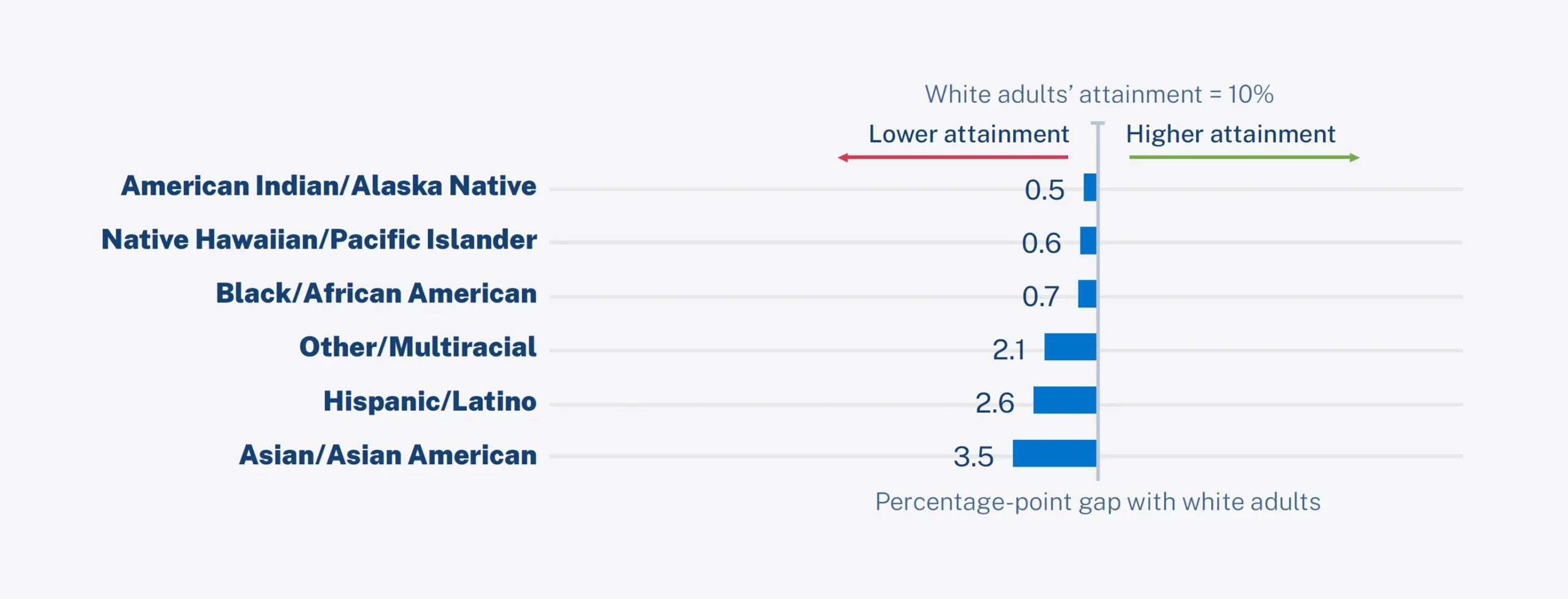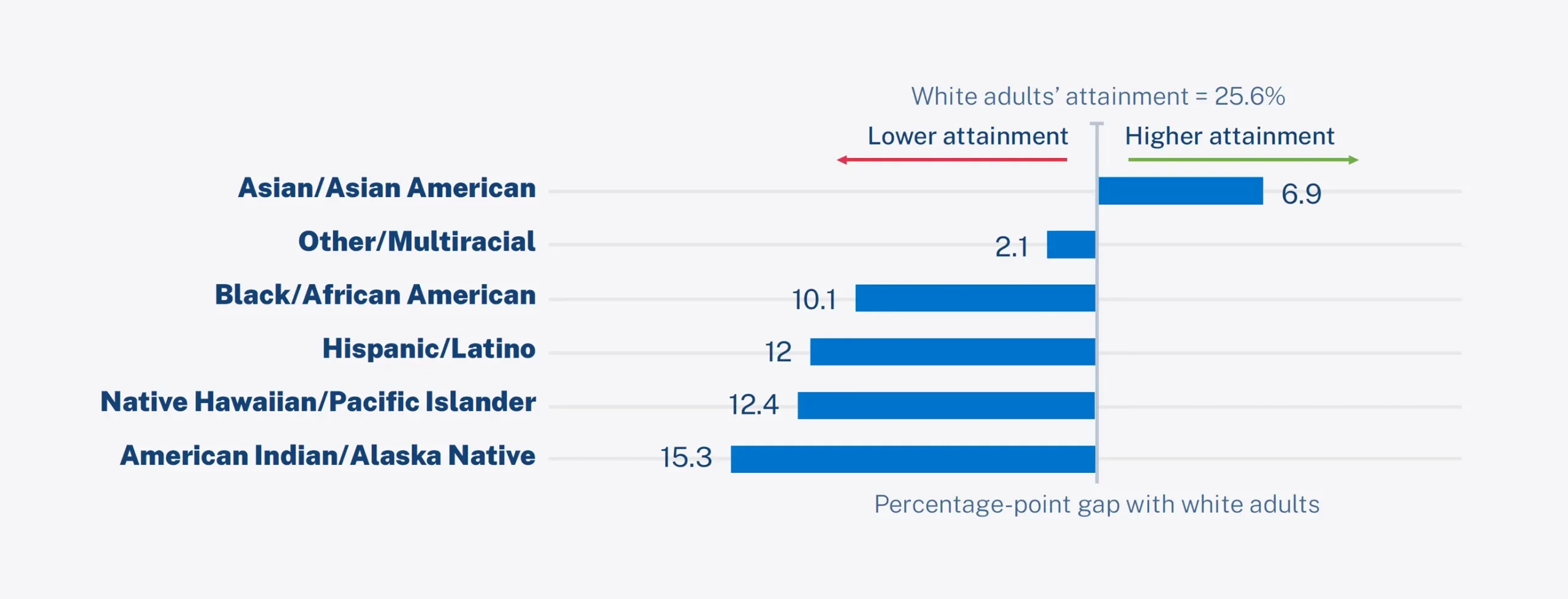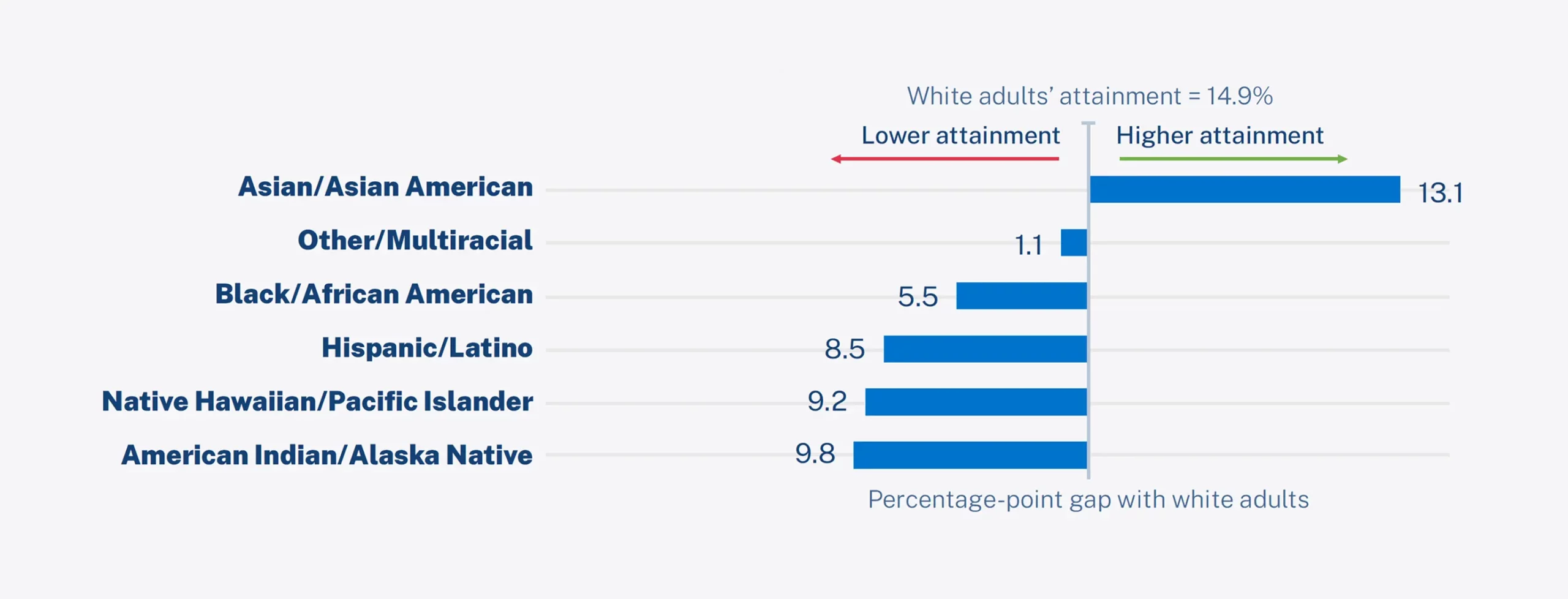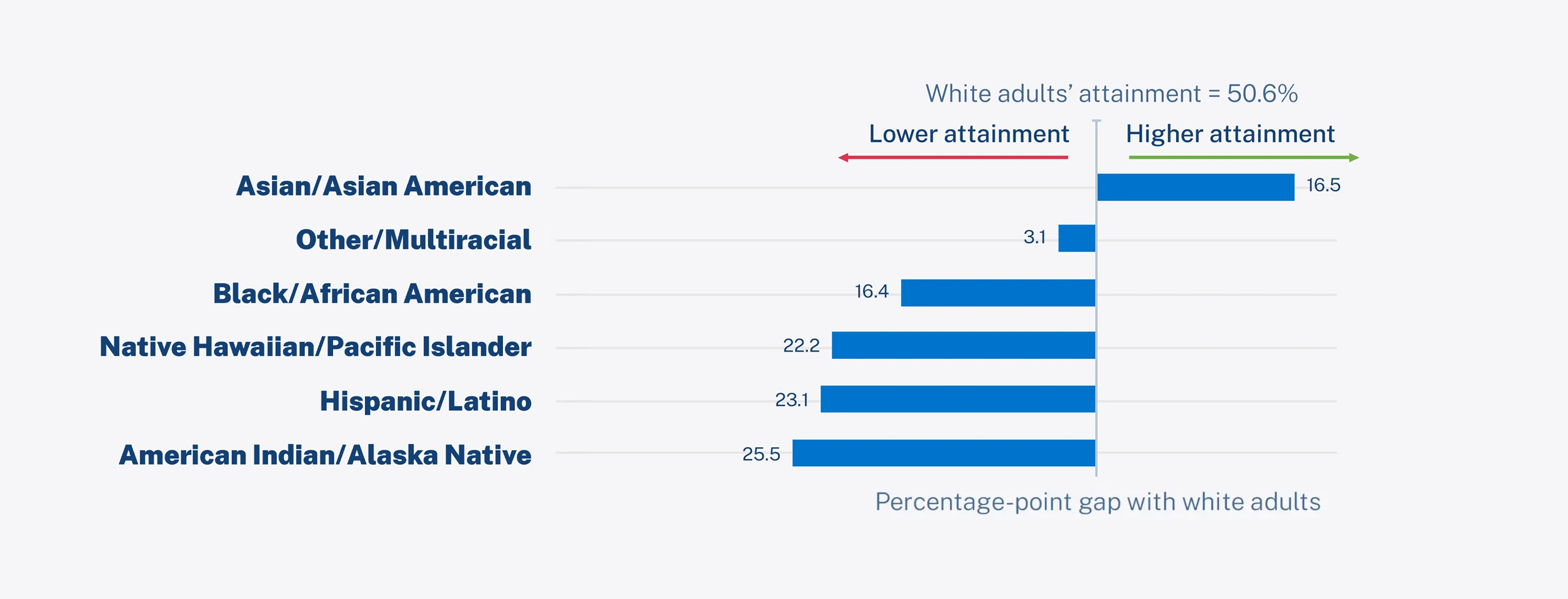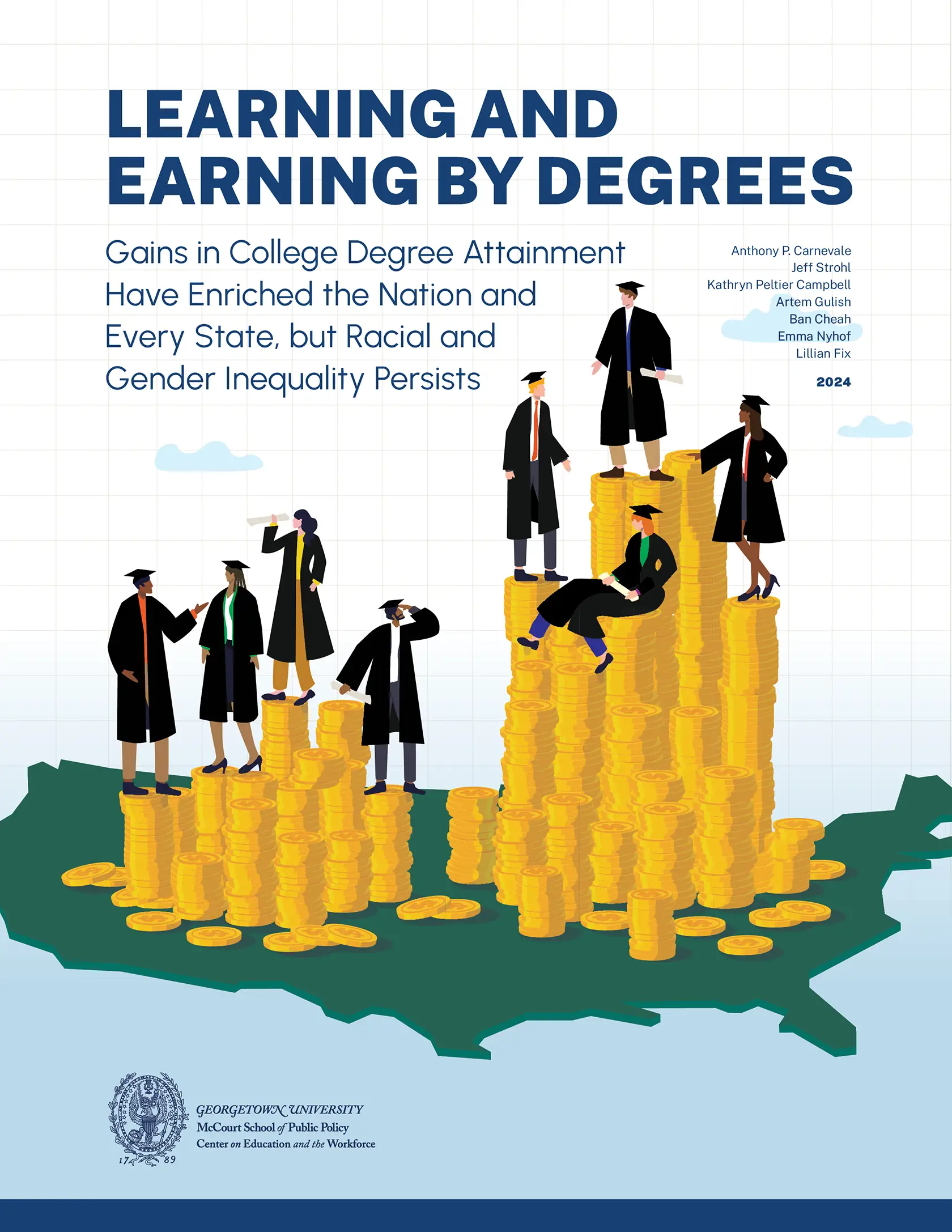Summary
Between 2010 and 2020, the proportion of US adults who hold college degrees increased by 6.7 percentage points, from 38.5 percent to 45.2 percent. According to Learning and Earning by Degrees: Gains in College Degree Attainment Have Enriched the Nation and Every State, but Racial and Gender Inequality Persists, this rising tide of educational attainment will lead to $14.2 trillion in additional net earnings for workers over their lifetimes, bolstering the US economy through additional spending and tax revenue. Beyond the monetary gains associated with increased educational attainment, individuals with higher levels of education also have better health outcomes, a stronger resistance to authoritarianism, and higher rates of civic engagement, among other benefits.
However, while all demographic groups experienced increases in college degree attainment, gaps in attainment and earnings persist between white adults and adults from marginalized racial/ethnic groups, undermining the capacity of education—by itself—to create an economically just world.
Source: Georgetown University Center on Education and the Workforce analysis of data from the US Census Bureau, American Community Survey (ACS), 2009–11 (pooled), 2019–21 (pooled), 2009–21 (pooled); National Center for Education Statistics (NCES), National Postsecondary Student Aid Study: 2016 (NPSAS: 2016) Undergraduate Students (UG) and Graduate Students (GR), 2016.
Note: Net lifetime earnings gains are the aggregate marginal gains relative to the expected lifetime earnings of high school graduates, adjusted for the costs of education (net tuition and fees and forgone earnings).
Attainment Gaps
Educational attainment gaps remain the most pronounced at the bachelor’s and graduate degree levels, where earnings are also highest. Between 2010 and 2020, college degree attainment gaps narrowed slightly between white adults and Hispanic/Latino adults, as did attainment gaps between white adults and adults from other/multiracial backgrounds. Meanwhile, degree attainment gaps widened between white adults and American Indian/Alaska Native adults, Native Hawaiian/Pacific Islander adults, and Black/African American adults, respectively. Asian/Asian American adults are the only racial/ethnic group to have higher educational attainment than white adults, and their advantage narrowed slightly over the period.
Only small attainment gaps by race/ethnicity exist at the associate’s degree level, while attainment gaps at the bachelor’s and graduate degree levels are more pronounced.
Source: Georgetown University Center on Education and the Workforce analysis of data from the US Census Bureau, American Community Survey (ACS), 2019–21 (pooled).
Note: Figure shows the percentage-point attainment gap with white adults based on the highest level of educational attainment within the population ages 25–64.
The Lost Earnings Associated with Inequality
Educational attainment gaps fuel earning gaps in the US economy, and they are not the only source of pay disparities. Factors such as occupational segregation, wage discrimination, and systemic barriers that affect hiring practices also come into play. Taken together, these factors help explain why, among adults with the same level of educational attainment, those from marginalized racial/ethnic groups often have lower median earnings than white adults. Gender disparities compound with racial/ethnic disparities to tell a similar story. Within nearly all racial/ethnic groups, women’s college attainment surpasses men’s, yet men continue to outearn women within the same racial/ethnic group at every degree level.
If all racial/ethnic groups had degree attainment at least as high as that of white adults, the nation’s workers would accrue an additional $11.3 trillion in net lifetime earnings on top of the $14.2 trillion they are already set to gain. If workers in each racial/ethnic group also had earnings at least as high as those of white adults with the same level of education, net lifetime earnings would rise by another $6.3 trillion.
Attainment Gains and Gaps by State
Across the US, attainment gains and gaps varied by state. The District of Columbia, North Carolina, Pennsylvania, Tennessee, and Kentucky experienced the highest levels of associate’s degree or higher attainment increases in their populations. On the other end of the spectrum, Oklahoma, Alaska, Hawaii, North Dakota, and Rhode Island experienced the lowest levels of degree attainment increases in their populations. Each state has the potential to create substantial monetary gains for workers and the economy by closing racial/ethnic and gender gaps in educational attainment and earnings.
Recommendations
Achieving educational and economic justice requires systemic reforms to close attainment gaps, improve employment opportunity, and ensure earnings parity by
- creating equitable opportunities for youth;
- fostering equal access to college degrees;
- ensuring equitable participation in high-earning majors;
- providing improved options for workers without college degrees; and
- seeking remedies for unequal pay in the labor market.
Resources
Learning and Earning by Degrees: Gains in College Degree Attainment Have Enriched the Nation and Every State, but Racial and Gender Inequality Persists finds that the US misses out on substantial lifetime earnings gains and social benefits due to educational attainment and earnings gaps.

